If you’re looking for spiritual renewal, you should definitely undertake the Char Dham Yatra. During this Yatra, you will visit four of the holiest destinations in India that are known for their blissful ambiance and divine atmosphere. The Char Dham Yatra comprises Yamunotri, Gangotri, Kedarnath, and Badrinath. Yamunotri is believed to be the sacred abode of Goddess Yamuna, Gangotri is dedicated to Goddess Ganga, Badrinath to Lord Vishnu, and Kedarnath to Lord Shiva. The pilgrimage starts at Yamunotri and culminates at Badrinath.
The Chardham Yatra grants spiritual enlightenment, divine blessings, and a once-in-a-lifetime chance for self-discovery. By visiting the sacred abodes you can seek blessings for yourself and your loved ones and spiritual guidance to navigate the challenges that you encounter in life. The Himalaya’s pristine and serene environment adds to the aura of spirituality. So don’t wait anymore! Book our Char Dham Yatra of Uttarakhand now to embark on a spiritual journey that will transform your life forever!
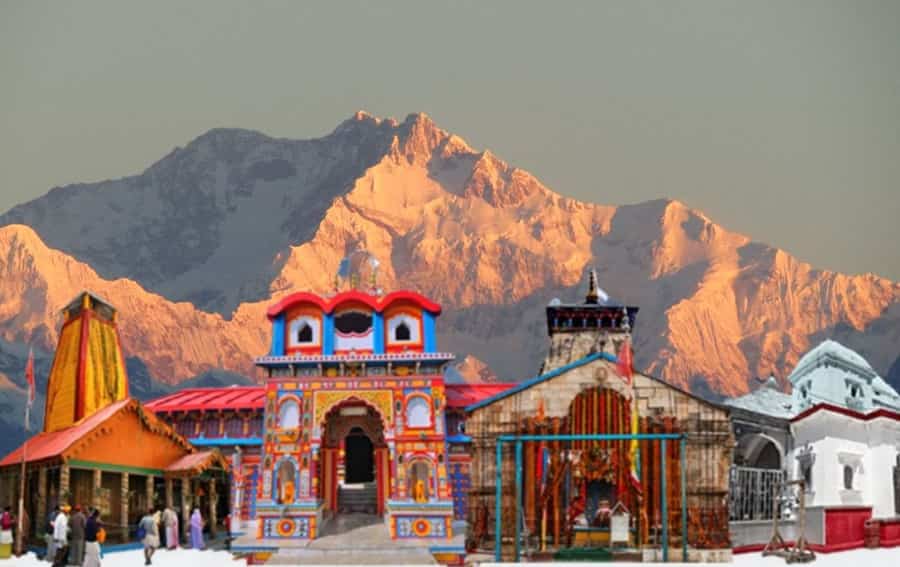
Chardham of Uttarakand
Yamunotri Dham
Yamunotri Dham is located in Uttarakhand’s Uttarkashi district and it holds lots of religious prominence in Hindu mythology. Yamunotri is believed to be the Yamuna River’s source. The Champasar Glacier is the place from where Yamuna originates around 4421 meters above sea level. Yamunotri Temple is the main attraction at Yamunotri, dedicated to Goddess Yamuna who is known to be the goddess of the river. Yamunotri temple was constructed by Tehri Garhwal ‘s Maharaja Pratap Shah and was later renovated in the 19th century by Maharani Guleria of Jaipur.
To reach the temple, you need to undertake around 6 6-kilometer trek from Janki Chatti. The trek passes through breathtaking sceneries, offering stunning views of the lush green valleys and Himalayan peaks. Gauri Kund and Surya Kund are two hot springs near the temple. Before entering the temple, pilgrims take a holy dip in these hot springs, as it cleanses their souls and bodies.
Gangotri Dham
Situated at around 3048 meters altitude, Gangotri is one of the most sacred pilgrimage sites. The place is known for the Gangotri temple which is dedicated to the River Ganga. Among all Ganga temples, Gangotri Temple is located at the maximum elevation and its prominence is also unrivaled. Amar Singh Thapa, a Gurkha leader, is believed to have constructed the Gangotri Dham temple. It is believed that the Ganges came to earth to wash away King Bhagirathi’s ancestors’ sins.
From the ancient period till the present time, for mankind, the River Ganga has been a source of purity. Gangotri Temple houses the idol of Goddess Ganga, who is believed to be the holy River Ganges personification. Devotees seek the goddess’s blessings for salvation and purity and offer their prayers to her. On the exterior, the temple features intrinsic sculptures. Peace seekers and nature lovers along with trekkers, are overwhelmed by the breathtaking views of Gangotri and adventurous walks through this enchanting place.
Kedarnath Dham
Kedarnath Dham is the prime attraction for worshipers of Shiva. It is situated amid the snow-capped peaks, forests of the Himalayas’ lower mountain range, and enchanting meadows. It is located in a picturesque location, near the Mandakini River’s source, and at 3,584 meters in height. It is considered to be one of the twelve Jyotirlingas and is an important temple among the Panch Kedars. Kedarnath Dham is also considered to be a part of the sacred Chota Char Dham Yatra. It is believed that Pandavas built this temple and Adi Shankara renovated it in the eighth century.
However, the temple has been renovated many times over the centuries because of the damage caused by natural disasters like avalanches and earthquakes. It has been built in North-Indian style architecture with grey slabs or stones that are interlocked using iron clamps. The irregularly shaped idol of Kedarnath is the main attraction of the temple accompanied by a pedestal that measures around 3.6 meters in height and circumference. In Kedarnath Temple, all the rituals and daily pujas take place under Rawal’s guidance, who is the temple’s main priest.
Badrinath Dham
Badrinath temple is one of the sacred Char Dham sites that holds immense importance for the Hindus. Its history can be traced back to the Vedic Age, which started in 1,500 B.C. The main highlight of the temple is the 3.3-foot-tall Lord Badrinarayan’s black stone idol sitting in a meditative pose under a canopy of pure gold and badri tree. Adi Shankara found Lord Vishnu’s fossilized black stone idol in the Alaknanda River. The idol is believed to be one of the eight most significant Svayam Vyakta Kshetras—Lord Vishnu’s idols that manifested on their own without the help of any human.
Since the 9th century, Badrinath temple has undergone many restorations and renovations, with its inner sanctum considered to be the only original part that remained undamaged. In the 17th century, the temple was expanded by Garhwal kings. The temple houses murtis of Kubera, Uddhava, Narada Muni, Nar and Narayana.
History of Char Dham Temples
Let’s take a look at the history of each of the four Char Dham sites.
Yamunotri
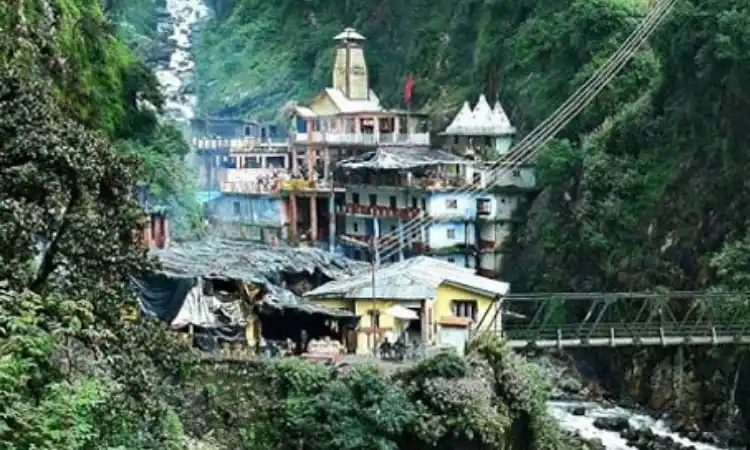
Yamunotri’s legend starts with the sacred Yamuna River’s birth. As per Hindu mythology, Yamuna is considered to be Sangya and Surya, the sun god’s daughter. From the heavens, Ganga descended and took a divine river’s form at the request of Yama, her brother and the god of death. It is said that Yamuna flowed on Yamunotri’s other side initially, and the sacred temple is located on the western bank. The river moved to the western side due to the tapas (austerities) performed by Due to the revered sage Asit Muni’s tapas, river Yamuna moved to the western side. Yamunotri is also known as Tapasthali, the penance place. It is believed that sage Asti Muni bathed daily in the “Yamunotri Kund,” thermal springs and performed rigorous penances.
Gangotri
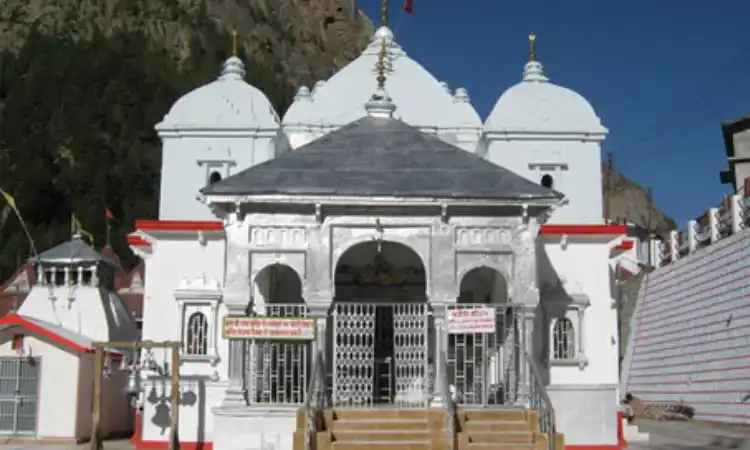
Gangotri Dham holds great relevance for Hindus as it is considered to be a sacred location. The river Ganges is believed to have been born from heaven. Lord Shiva allowed the river Ganga to find its earthly at Gangotri and later he held her in his locks. Consequently, from Shiva’s matted hair, the holy river descended on earth. It is believed that King Bhagirath performed austerities because of which the heavenly Ganga had to descend to Earth. Lord Brahma listened to King Bhagirath’s prayers and the river Ganga began to flow. It is believed that the holy river moves along the footpath that has been created by the Lord Shiva’s hair. A cleansing dip in river Ganga’s holy water in Gangotri is believed to be a grace for Hindu devotees. A holy dip into the Ganges sacred water has the ability to cleanse all the sins of mankind.
Kedarnath
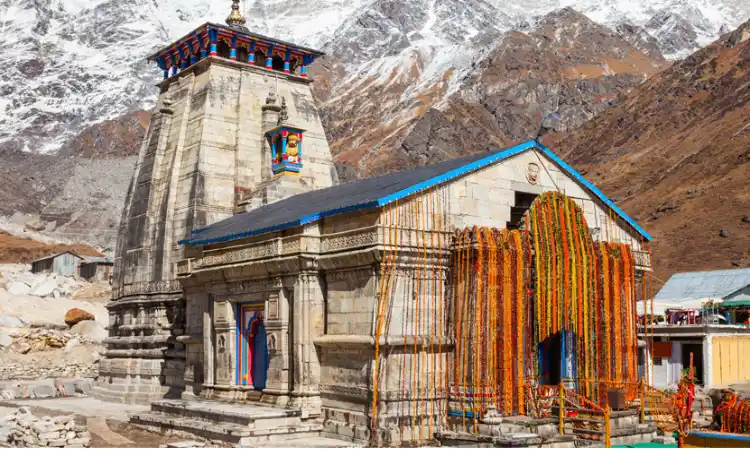
The Kedarnath Temple’s origin dates back to the ancient period. As per Hindu mythology, Pandavas, Mahabharata’s legendary heroes built Kedarnath. Legend has it that the Pandavas sought the forgiveness of Lord Shiva after the Kurukshetra War so that they could get away from the sins committed during the battle. However, the Pandavas were evaded by Lord Shiva as he got transformed into a bull. After a rigorous search, the Pandavas reached Kedarnath, where the bull’s hump is said to have appeared. It also marks the site of the divine temple. Over the years, the temple has been renovated many times. The temple looks beautiful with a stone edifice with a towering Shikhara and intricate carvings that are considered to be an important characteristic of the temple architecture of North India. The temple’s unique combination of spirituality and artistry continues to captivate everyone.
Badrinath
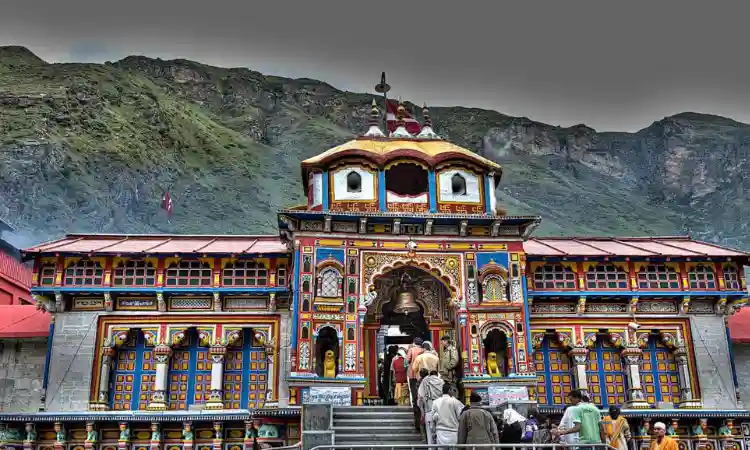
Badrinath is known as Astam Baikuntha. It is considered to be the place where the Vedic Samhitas were divided by Veda Vyasa into different sections. In Badrinath, Ved Vyas Rishi’s cave is located. As per Hindu mythology, Badrinath has been named after the Badri tree under which Vishnu meditated for thousands of years. Badrinath is known to be Lord Vishnu’s earthly abode in his Nar-Narayan form. As per the legend Lord Vishnu chose the pristine and serene location of Badrinath in his quest for penance and meditation to perform austerities. Lord Vishnu took Nar-Narayan’s form and meditated for thousands of years. Goddess Parvati and Lord Shiva pleased with his devotion decided to test his steadfastness.
Various temptations and challenges were thrown his way to test him. Yet he remained undeterred and sought spiritual enlightenment. The meditation of Lord Vishnu culminated in Badrinath’s divine revelation. Badrinath temple is famed for its spiritual aura and distinctive architecture and it testifies to the divine presence that permeates Badrinath’s sacred land. It is also believed that Lord Ram worshipped Narayan at the Badrinath Temple.
Best Time to Visit Char Dham Sites
May and June, before the arrival of the monsoon, are considered to be the best time to visit Char Dham sites. September to early November, after the monsoon season’s offset, is also a great time to visit Char Dham sites. During this time of the year, the paths are safer for trekking and the weather is quite pleasant allowing you to explore all four destinations without any hassle. You should avoid visiting the Char Dham sites during the monsoon season which typically lasts from July to August due to potential road blockages and frequent landslides. It’s also important to note that during the harsh winter months the temples close due to heavy snowfall. The temples again reopen in May if the weather is apt for travel.
- Gangotri Opening Closing Dates: April/May to October/November
- Yamunotri Opening Closing Dates: April/May to October/November
- Kedarnath Opening Closing Dates: April/May to October/November
- Badrinath Opening Closing Dates: April/May to October/November
Chardham Yatra Route Map
Sequence of Temples:
- Yamunotri
- Distance from Haridwar: 220 km (approx. 7 hours)
- Route: Haridwar → Barkot → Janki Chatti (6 km trek)
- Gangotri
- Distance from Yamunotri: 100 km (via Uttarkashi)
- Route: Barkot → Uttarkashi → Gangotri
- Kedarnath
- Distance from Gangotri: 180 km (to Rudraprayag, then trek)
- Route: Uttarkashi → Guptkashi → Sonprayag → Gaurikund (20 km trek)
- Badrinath
- Distance from Kedarnath: 160 km
- Route: Gaurikund → Guptkashi → Rudraprayag → Badrinath
Return Route:
- Rishikesh → Haridwar → Delhi
Total Distance
- Round Trip: 1,607 km
Important Notes
- Ensure to check road conditions.
- Driving restrictions apply in hilly areas from 8 PM to 4 AM.
Chardham Yatra Route from Delhi
If you’re starting the Char Dham Yatra from Delhi, then you can either head to Haridwar by train or fly to Dehradun. Let’s take a look at the route you’ll cover if you start your Char Dham journey from Delhi.
Delhi: If you embark on the sacred Char Dham Yatra from the capital city of Delhi you can opt for different transport modes, like flights, buses, and trains since the city has good connectivity with the rest of the country with airports, railway stations, and bus stations that operate flights, trains and buses at frequent intervals from different parts of the country.
Haridwar: The next leg of the journey is Haridwar. From Delhi, you’ll have to reach Haridwar which is located in Uttarakhand. You can reach Haridwar from Delhi through around 6-hour drive covering around 205 km distance. Haridwar is a scenic heaven and a sacred destination that houses many holy Ghats, shrines, and temples with it also being the Kumbh Mela’s holy site.
Barkot: From Haridwar, you will head to Barkot which is situated in the Uttarkashi district of Uttarakhand. After reaching Haridwar, you’ll embark on a drive to Barkot covering around 215 km distance in 5 to 6 hours. Barkot is situated in the Garhwal Himalayas and offers breathtaking views of the Bandarpunch Peak. It is a trekking paradise and a haven for nature lovers.
Yamunotri: From Barkot you’ll head to the Yamunotri Temple, which is one of the first destinations included in the Char Dham sites. You will embark on a serene drive from Barkot and reach Yamunotri. After the Darshan, you will head back to Barkot covering around 42 km distance and a 6 km trek. The Yamunotri Temple is believed to be the sacred abode of Goddess Yamuna. It is situated at a height of 10,804 ft. and houses a natural hot spring known as Surya Kund.
Uttarkashi: From Barkot, you will head to Uttarkashi. You will have to undertake a 4-hour drive covering around 82 km distance. Uttarkashi is a spiritual destination dotted with numerous shrines and temples dotted along its landscape. Uttarkashi also houses the Vishwanath Temple which is known to be the sacred abode of Lord Shiva.
Gangotri: From Uttarkashi, you’ll head to Gangotri. You’ll embark on a picturesque drive from Uttarkashi, covering around 100 km distance one way, and then you’ll go back to the town once you have visited the holy temple. Gangotri Temple is known to be the sacred abode of Goddess Ganga. River Ganga’s source is also situated near the temple.
Guptkashi: From Uttarkashi, you’ll head to Guptkashi which is situated at a distance of around 223 km. It will take around 9 to 10 hours to complete the journey. With the breathtaking backdrop of the Nanda Devi, Chaukhamba, Deo Tibba, and Panchachuli peaks, Guptkashi is an absolute haven that gets dotted during the summer months with beautiful flowers. Guptkashi is dotted with many temples that are dedicated to Lord Shiva.
Kedarnath: From Guptkashi, you’ll head to the Kedarnath Temple, one of the most famous pilgrimage sites. The temple is situated at around 32 km distance from Guptkashi and involves a 16 km challenging trek to reach the top. Kedarnath is considered to be one of the highly sacred shrines dedicated to Lord Shiva. Due to high snowfall, the temple remains closed during the winter.
Chopta: Once you have visited the Kedarnath temple, you will head to Chopta via Gaurikund. The journey will involve a 14 km challenging trek with a picturesque drive of around 90 km to reach Chopta. Gaurikund houses the Gaurikund temple which is the sacred abode of Goddess Parvati. From Gaurikund, you will head to Chopta, which is often considered to be the Switzerland of India.
Badrinath: From Chopta, you will head to the Badrinath Temple. You can reach the Badrinath temple from Chopta by embarking on a drive of around 6 to 7 hours and covering around 160 km distance. Badrinath Temple is dedicated to Lord Vishnu. It was constructed in the ninth century by Adi Shankaracharya.
Rudraprayag: From Badrinath, you will head to Rudraprayag covering around 160 kms distance in around 6 to 7 hours. Rudraprayag has been named after Lord Shiva’s Rudra avatar. It is located at the confluence of the rivers Mandakini and Alaknanda. It has many sacred shrines and temples.
Rishikesh: From Rudraprayag, you will head to Haridwar via Rishikesh. Rishikesh is dotted with tons of meditation and yoga centers. It is also known to be the ‘Yoga Capital of the World’. From Rishikesh, you will head to Delhi. The Char Dham tour will end in Delhi.
Char Dham Yatra Driving Directions
Route:
Delhi → Haridwar → Barkot → Yamunotri → Uttarkashi → Gangotri → Guptakashi → Kedarnath → Badrinath → Rishikesh → Delhi
Distances and Travel Times
- Delhi to Haridwar: 210 km (approx. 6 hours)
- Haridwar to Barkot: 220 km (approx. 7 hours)
- Barkot to Yamunotri: 36 km (drive) + 7 km (trek)
- Barkot to Uttarkashi: 100 km (approx. 4 hours)
- Uttarkashi to Gangotri: 100 km (approx. 4 hours)
- Uttarkashi to Rudraprayag: 180 km (approx. 7-8 hours)
- Rudraprayag to Kedarnath: 74 km (drive) + 18 km (trek via New Route)
- Rudraprayag to Badrinath: 160 km (approx. 6-7 hours)
- Badrinath to Rishikesh: 297 km (approx. 10-11 hours)
- Rishikesh to Delhi: 230 km (approx. 6 hours)
Registration for Chardham Yatra
You can register for Char Dham Yatra through various ways which have been listed below:
- Through the Uttarakhand Tourism Development Board’s website, you can register for the Chardham Yatra. The website deals with the pilgrimage tours in the state. You can access the website at https://registrationandtouristcare.uk.gov.in/
- The pilgrims can also use the WhatsApp facility to register for the yatra. You can send “Yatra” to +91 8394833833 for the process.
- Through ‘Tourist Care Uttarakhand’, which is their mobile app you can register for the Yatra.
During the Yatra, you should carry your identity card for a hassle-free travel experience.
Best Places to Visit during Char Dham Yatra
Let’s take a look at the top destinations that you can visit during the Char Dham Yatra.
Rudranath Temple
Rudranath Temple is considered to be one of the five Panch Kedar temples situated in Uttarakhand’s Garhwal Himalayas. It is the sacred abode of Lord Shiva where he is worshipped in the form of Ekanan. Rudranath Temple is located at around 3,550 meters altitude above sea level. It is surrounded by lush green forests of alpine pastures and rhododendron dwarfs.
Tungnath Temple
Tungnath Temple is situated at a height of around 3680 meters above sea level. It is a shrine of Lord Shiva and one of the five Panch Kedar temples that is dedicated to the different forms of Lord Shiva. It is also one of the best trekking destinations that offers a thrilling and picturesque journey through the mountains. Pandavas built this temple as a tribute to Lord Shiva.
Madhyamaheshwar Temple
Madhyamaheshwar Temple is the sacred abode of Lord Shiva situated in the Himalayas. It falls within the Garhwal area and is considered to be the site where the stomach of Lord Shiva fell when he was a bull. The temple is considered to be one of the Panch. It is also the starting point for many difficult hikes, like Kanchani Tal. Madhyamaheshwar Dham also offers a view of Uttarakhand’s most picturesque scenery.
Omkareshwar Temple
Omkareshwar Temple is situated amidst the stunning backdrop of the Garhwal Himalayas in Ukhimath and testifies to spirituality and devotion. It is a sacred shrine and Lord Kedarnath’s winter abode. The peaceful aura and divine ambiance of the temple attract both devotees and tourists alike, offering a sanctuary of serenity and peace amidst the breathtaking Himalayan landscape.
Kalimath Temple
Kalimath Temple is situated in Uttarakhand’s Rudraprayag district and is dedicated to Goddess Kali. It is one of the one hundred and eight Shakti Peethas where Sati’s back fell. Unlike the other temples, it doesn’t have an idol of Goddess Kali but the devotees offer their prayers to a sacred pillar that symbolizes the Goddess.
Triyuginarayan Temple
Triyuginarayan is a renowned Hindu pilgrimage site that is situated in the Rudraprayag district of Uttarakhand. The village provides breathtaking views of the beautiful Garhwal region’s snow-covered mountains, making it a great site for both nature enthusiasts and pilgrims. This place is famed for the Triyuginarayan Temple which is dedicated to Lord Vishnu. The architecture of this temple will remind you of the Badrinath shrine.
Koteshwar Mahadev Temple
The Koteshwar Mahadev Temple is situated in Uttarakhand and is a revered Hindu temple. It is the sacred abode of Lord Shiva that holds immense significance for devotees. It is situated near Rudraprayag, at the confluence of the Mandakini and Alaknanda rivers amidst the snow-capped Himalayas. As per the legend, it is believed that Lord Rama meditated at this spot to get rid of the sins of killing Ravana.
Devprayag
Devprayag is known for its historical importance, natural beauty, and spiritual significance. This charming town is considered to be the sacred confluence point of two of the Bhagirathi and Alaknanda Rivers, which together constitute the holy river Ganges. The strategic location of this town makes it a starting point for many outdoor expeditions, treks, and hikes.
- Suggested to Read: Char Dham Yatra Helicopter Booking Guide 2025
How is Uttarakhand Government Promoting Char Dham Yatra?
The governing authorities of Uttarakhand are undertaking several key initiatives to promote the Char Dham Yatra. Some of their initiatives are listed below:
- They are focusing on ensuring a seamless and enriching experience for pilgrims and encouraging state tourism. For instance, the government is continuously investing in improving road connectivity.
- The Uttarakhand government is also focusing on arranging budget-friendly accommodations to attract more tourists. Moreover, the authorities are undertaking numerous steps to improve disaster management and enhance safety standards.
- The government has also introduced an online registration and ticketing system to manage crowds, especially during the peak season. Online registration aids in reducing long waiting times by booking advance darshan slots. In addition, this initiative helps travelers enjoy an enriching and lifetime pilgrimage experience.
- They are also launching several domestic and international promotional campaigns to promote the cultural and religious significance of Devbhoomi. They are sending their representatives in tourism fairs and also launching digital platforms to provide required insights to pilgrims.
Travel Tips for Char Dham Yatra
- Seek the assistance of professional tour guides to ensure a fuss-free and safe journey. Be well-prepared in advance for the rugged expedition and challenging Himalayan climate.
- Carry all the important medicines for common issues such as body aches, headaches, and stomach disorders. You should also carry prescribed medications in case you have any health-related concerns. You should be prepared for the challenging journey and unexpected weather conditions during the Char Dham Yatra.
- Before embarking on the Char Dham Yatra you should consult a healthcare professional, especially if you’re dealing with any pre-existing health conditions.
- Wear loose-fitted clothes and sturdy footwear to ensure you can have a hassle-free journey.
- Book a hotel in advance especially if you’re traveling in peak season to deal with any kind of last-minute hassle.
- Arrange for transportation, whether you’re traveling by helicopter or road, keeping in mind the accessibility and terrain of the Char Dhams.
Suggested Tour Itinerary
COMMENTS